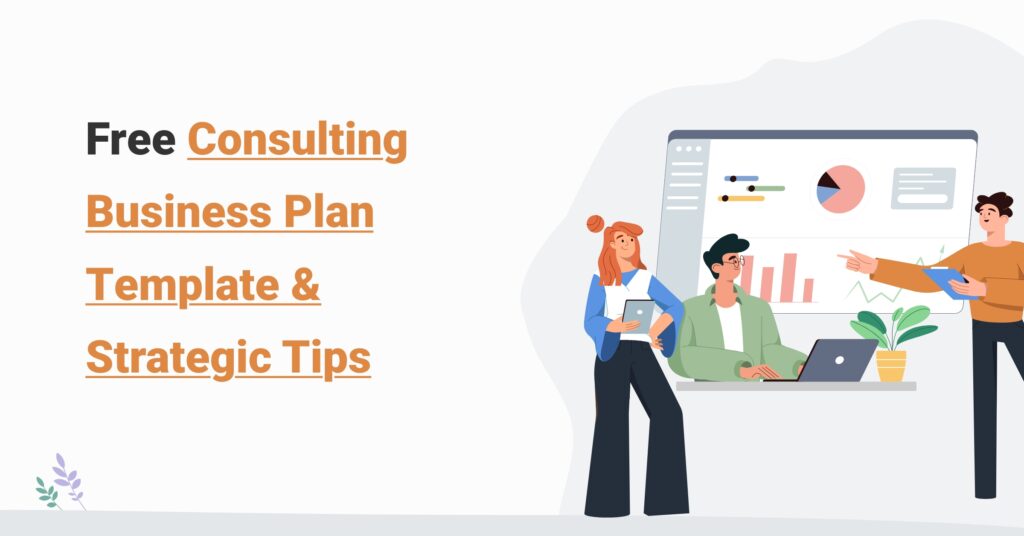Table of Contents
Free Consulting Business Plan Template & Strategic Tips
Starting a consulting business without a plan is like setting off on a road trip without a map—you’ll eventually get somewhere, but the journey will be longer, costlier, and far riskier than it needs to be.
A consulting business plan is that roadmap.
It clarifies your business goals, defines the services you’ll offer, pinpoints your ideal clients, and lays out the strategy to scale sustainably in a competitive market.
💡 And the numbers don’t lie: Companies with a written business plan grow 30% faster, and 71% of high-growth firms attribute much of their success to formal planning. Without one, you’re left vulnerable to the same pitfalls that cause 80% of consulting startups to shut down within two years—lack of market demand, unstable cash flow, and poor strategic execution. In short, planning isn’t optional; it’s survival.
That’s where this guide comes in.
Whether you’re an independent consultant, building a boutique firm, or leading a strategic advisory practice, this resource is built to set you up for success. You’ll get:
- A free, ready-to-use business plan template custom for consultants
- A real-world example plan to see what “good” looks like in practice
- Actionable strategic tips to refine your positioning and impress stakeholders
By the end, you’ll not only have a plan on paper—you’ll have a structured path to growth, clarity in execution, and the confidence to build a consulting business that thrives, not just survives.
What is a Consulting Business Plan, and Why Do You Need One?
A consulting business plan is a document that lays out the key elements of your consulting firm “what services you provide, who your clients are, how you’ll market and deliver those services, and how the financials stack up (revenues, costs, and profits)”.
👉 In short, it’s the blueprint for your strategy and operations. It takes the core framework of a traditional business plan and adapts it to consulting, where your services and expertise are the actual product.
It creates clarity. A plan forces you to answer critical questions: What services should you prioritize? How do you price? Who’s your ideal client, and how will you scale? Without it, you risk cash flow gaps, poor positioning, or stalled growth.
▶️ Bottom line: If you’re serious about building a sustainable consulting practice, you need a plan—concise, practical, and evolving with your business.
Consulting Business Plan Template & How To Use It?
A business plan template isn’t just a fill-in-the-blanks document, it’s a framework designed to keep your consulting practice focused, structured, and scalable.
👉 Here’s your Free Business Plan Template for Consultants to jumpstart your planning!
Now, let’s see how to actually put the template into action.
1. Treat It Like a Working Blueprint
Don’t fill it out once and file it away. Use the template as a living document — update it when you refine your services, adjust pricing, or target a new client segment. This way, your plan evolves with your business instead of becoming outdated.
2. Use It to Spark Strategic Clarity
The template forces you to answer tough but essential questions:
- Who exactly is my ideal client?
- How will I package services?
- What’s the most profitable delivery model?
Thinking through these systematically gives you clarity you can use in day-to-day decision-making.
3. Connect It With Tools You Already Use
Instead of treating the plan as theory, integrate it with your operations. For example, align the “Services & Revenue Model” section with your invoicing system, or link your “Operations Plan” to project management tools like Avaza. This bridges strategy and execution.
4. Share It With Stakeholders
If you’re seeking funding, building partnerships, or growing a team, your completed template becomes a professional artifact. It communicates vision and structure to investors, collaborators, and even clients who want confidence in your approach.
5. Revisit It Regularly
Set reminders for quarterly reviews.
Ask:
- What assumptions proved true?
- What changed in the market?
- Which service lines are most profitable?
By revisiting, you’ll keep your plan aligned with reality instead of wishful thinking.
✅ Quick Tip: Download the free consulting business plan template provided with this guide and spend a focused half-day filling it out. By the end, you’ll have more than a document — you’ll have a roadmap that connects your strategy, operations, and growth goals in one place.
From Plan to Action: Using Avaza to Run Your Consulting Business
Writing a business plan is a milestone worth celebrating, but the real challenge begins when you start turning that strategy into daily operations.
For consultants, success lies not only in winning clients but also in managing projects, people, and cash flow smoothly. This is where technology makes a difference.
Avaza, an all-in-one platform, bridges the gap between planning and execution, helping you run your consulting business like a well-oiled machine.
1️⃣ Seamless Project Management
Landing clients is just the first step. Delivering on your promises requires structure. Avaza’s project management module lets you set up each engagement with tasks, deadlines, and deliverables tied to the scope you defined in your proposals.
If your framework includes a 5-step process, you can mirror it directly in Avaza, assigning owners and timelines.
Visual tools like Kanban boards, Gantt charts, and task lists give you multiple ways to track progress, ensuring you stay aligned with your plan’s capacity assumptions.
With real-time workload monitoring, you’ll know immediately if you’re overbooked or running on schedule.
2️⃣ Time Tracking & Billing Made Simple
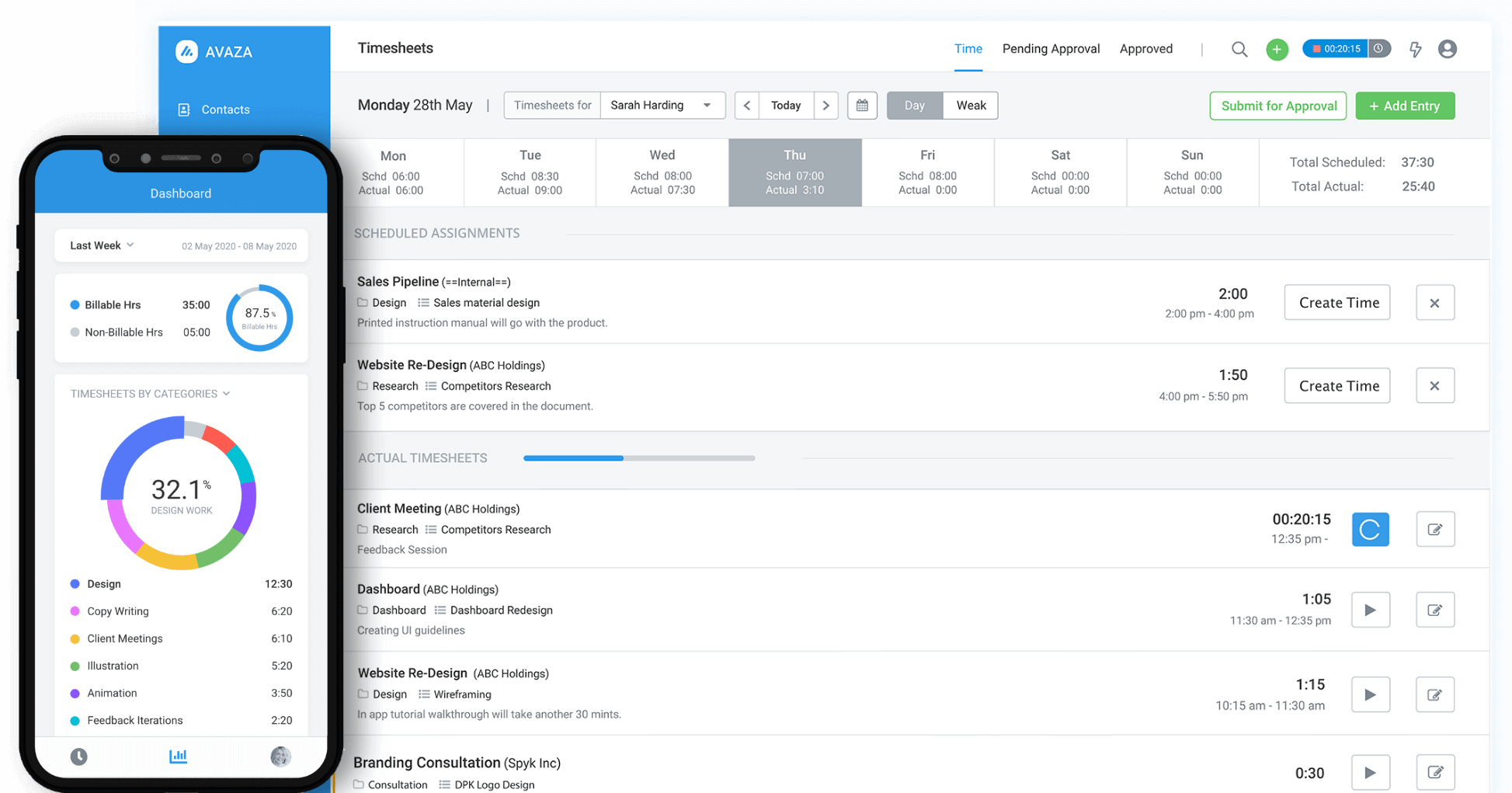
Consulting success often hinges on utilization and billable hours. Avaza integrates time tracking into your workflows, allowing you and your team to log hours effortlessly against specific tasks.
This data serves two purposes: it helps you measure actual effort against estimates (so future proposals become sharper) and feeds directly into billing.
No more lost hours or manual calculations because Avaza makes sure every billable minute is captured.
Utilization reports let you check whether you’re hitting plan targets, like maintaining 70% billability across your team.
3️⃣ Expense Management That Works in Real Time
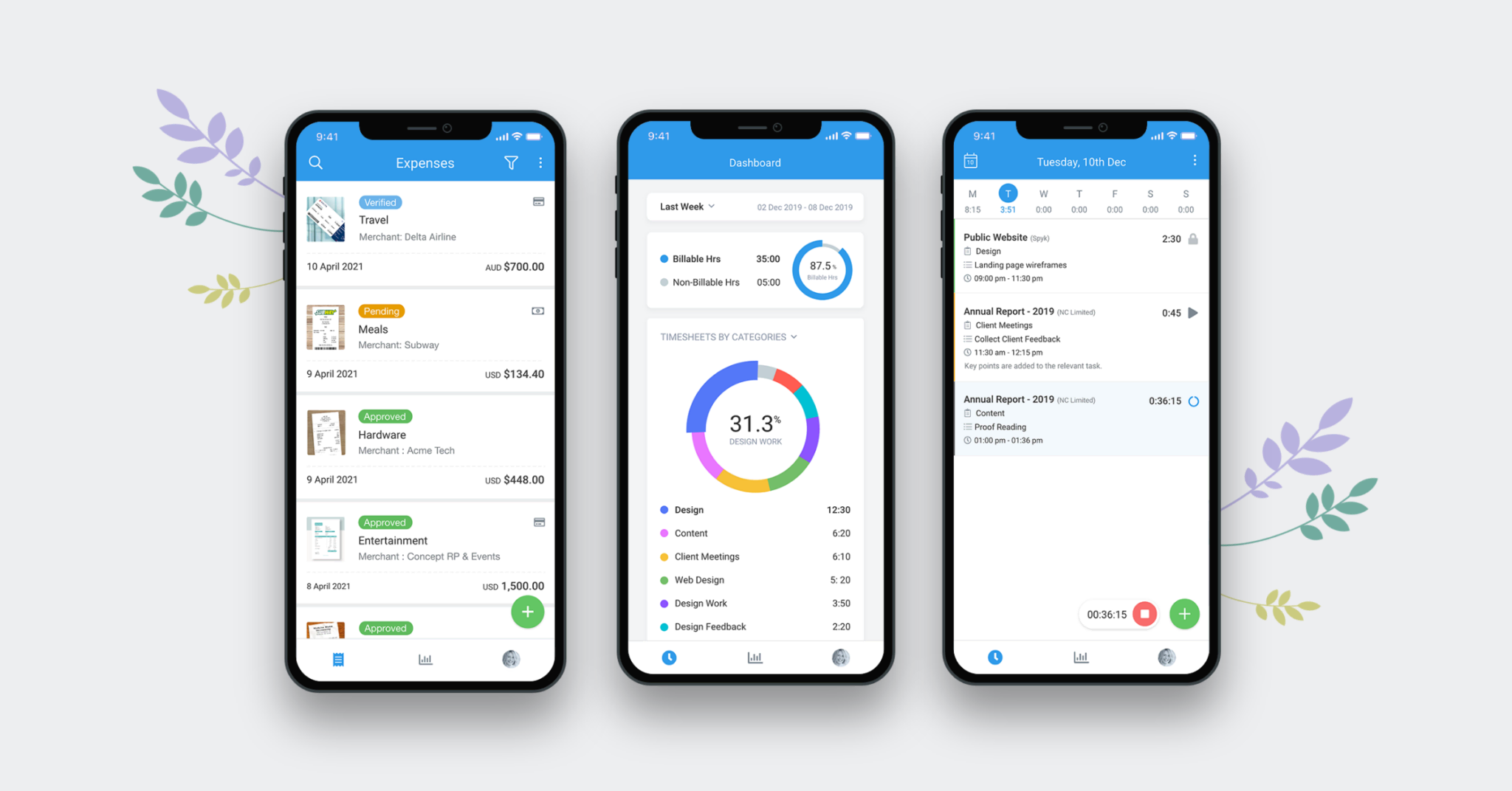
Expenses like travel, meals, incidentals are part of consulting life, and mismanaging them can erode margins.
Avaza makes expense capture painless. Snap receipts on the go, categorize them by project, and attach them to invoices when needed.
This keeps your reimbursements timely and makes sure your cash flow reflects the reality of your projects.
Over time, expense reporting can also inform smarter pricing, for instance: if your plan assumes 5% of fees for expenses but data shows it’s closer to 8%, you can adjust quotes accordingly.
4️⃣ Professional Invoicing & Faster Payments
Cash flow projections mean little without timely invoicing. Avaza automates this process with professional, branded invoices that pull in hours, rates, and expenses from your project data.
Clients receive polished invoices complete with online payment links, making it easier for them to pay quickly. Reduced DSO (days sales outstanding) keeps your financial health on track.
For retainer-based clients, recurring invoices can be set up once and run automatically, giving you predictable revenue streams that align with your growth plan.
5️⃣ Smarter Resource Scheduling
Scaling your consulting practice requires visibility into your team’s workload. Avaza’s resource scheduling offers a clear picture of who is working on what and when.
This helps you forecast hiring needs, balance project loads, and avoid over-promising.
💡 For example, if you see utilization hitting 100% consistently, it signals the right time to bring in additional support just as your plan anticipated.
By turning abstract capacity models into a tangible calendar, Avaza makes growth decisions far more actionable.
6️⃣ Collaboration & Client Transparency
A successful consulting engagement doesn’t end with deliverables whether it depends on clear, consistent communication.
Avaza centralizes discussions through built-in chat and project portals, making sure your team stays aligned.
Clients can also be invited into the portal to view progress or access files, giving them visibility into the project’s lifecycle.
This transparency not only builds trust but also enhances client retention, a priority in most business plans.
7️⃣ Data-Driven Insights for Continuous Improvement
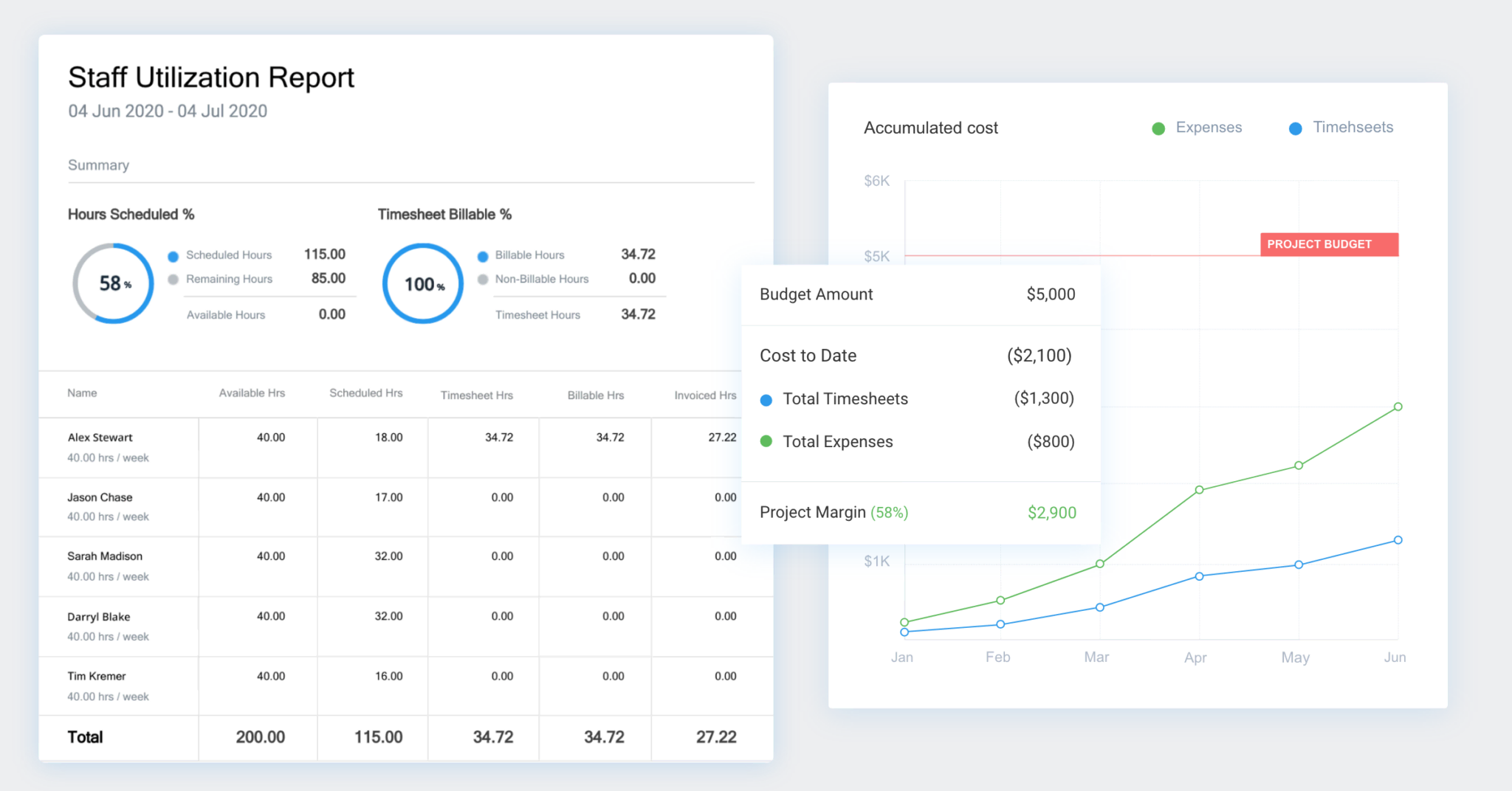
Your business plan shouldn’t sit on a shelf “it should evolve”. Avaza’s reporting features give you access to financials, utilization, and project profitability in real time.
By comparing actuals against projections, you can identify where your assumptions were accurate and where adjustments are needed.
💡 For example, if certain service lines consistently deliver higher margins, you can double down on them.
Avaza proactively becomes your live dashboard, powering the data-driven management your plan calls for.
8️⃣ Built to Scale with Your Business
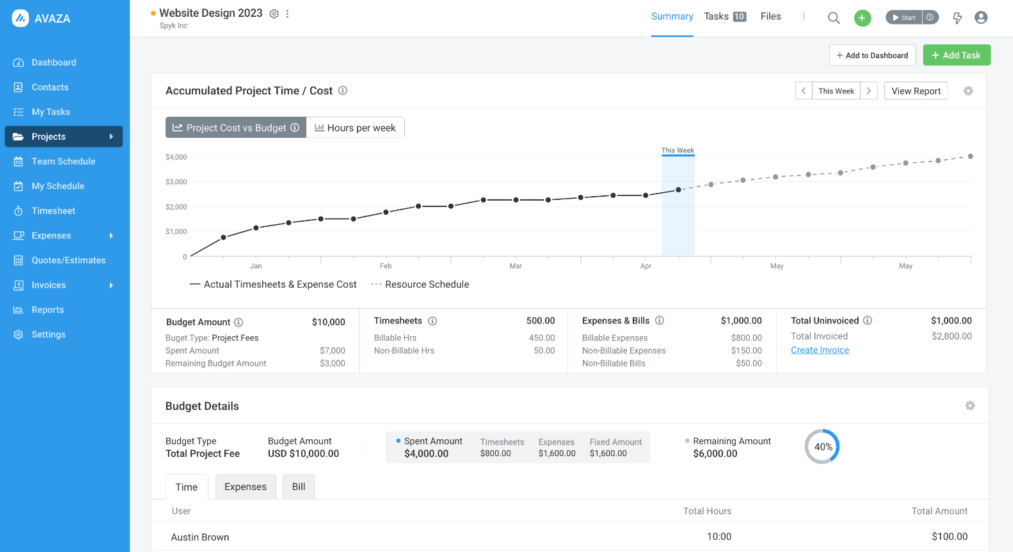
Growth brings complexity, but Avaza grows with you. Adding consultants, subcontractors, or new service lines is seamless.
Integration with accounting, CRM, and other business tools makes sure your operations remain cohesive as you expand.
This scalability means the processes you establish today won’t need a disruptive overhaul tomorrow, protecting your momentum as your consulting practice matures.
💡 In essence: Avaza isn’t just software; it’s the operational backbone that helps ensure your strategic business plan translates into measurable results. It reduces admin load, improves visibility, and keeps you focused on client service and revenue generation. By combining your roadmap with Avaza’s toolset, you set the stage not only for successful execution but for sustainable growth.
👉 Plan, execute, grow. With Avaza in place, your consulting vision has the infrastructure it needs to become reality.
How to Write a Consulting Business Plan (Step-by-Step)
Writing your consulting business plan isn’t about filling in boxes, it’s about creating a document that ties your vision to execution.
The best way to approach it is to break the plan into clear sections, each answering one critical question about your business.
The sections below are designed to walk you through that journey, starting with the big picture and narrowing down into execution and numbers.
💡 Think of it as moving from vision to reality.
Executive Summary
Every consulting plan begins with a clear story. The executive summary is that story, condensed into a page or two.
Here, you define your essence as a consulting business:
- The specific problems you solve.
- The ICP (ideal client profile) you serve.
- The differentiators that set you apart.
- The growth milestones you’re aiming for.
It’s not a place for detail—it’s about clarity and conviction. Done right, it functions like a pitch: whether a potential partner, client, or funder reads it, they should immediately grasp your model and be drawn to learn more.
Once this foundation is laid, you can expand into the “who” and “how” of your consulting firm.
Company Overview & Business Model
The company overview builds context around your practice. Where the executive summary is the high-level hook, this section explains structure and identity.
Here you articulate:
- Your firm’s setup: Name, legal structure, and stage of growth.
- Mission and vision: Not generic slogans, but a clear picture of what you do for clients and where you want the firm to be in 3–5 years.
- Business model: Whether you operate as a solo consultant focused on deep engagements, a boutique firm leveraging subcontractors, or a productized model delivering repeatable frameworks.
This is where potential readers understand your “architecture”—how your consulting practice is designed to deliver value. And it naturally flows into a bigger question: is there a strong enough market for this structure to thrive?
Market Analysis & Target Clients
A consulting business without market validation is built on assumptions. This section transforms assumptions into insights.
You begin by sizing the industry landscape growth trends, emerging challenges, and the demand drivers shaping your niche. Then, you narrow in on your ICP: the industries, company sizes, and decision-makers who feel the pain points you solve most acutely.
💡 For example, if you advise on compliance, your ICP may be mid-market healthcare firms with under-resourced legal teams. If you provide digital strategy, perhaps it’s established B2B companies struggling with legacy systems.
From there, you acknowledge the competitive landscape—from Big Four players to independent rivals and even internal teams.
Finally, you crystallize your competitive advantage: “the expertise, framework, or delivery style” that positions you as the obvious choice.
This section sets the stage for your services, it proves that the consulting model you outlined is backed by market demand.
Services & Revenue Model
Once demand is established, you explain how you meet it.
Here you outline your core services, packaged in a way that resonates with your ICP’s challenges:
- Diagnostic audits for clarity.
- Strategy roadmaps for direction.
- Implementation support for execution.
- Retainers for long-term advisory.
Then you layer in your delivery model—short projects, ongoing engagements, or blended approaches—and your pricing strategy, whether hourly, project-based, retainer, or value-based.
By connecting services to client pain points (outlined in your market analysis), this section shows that you’re not selling hours—you’re selling solutions with measurable ROI. This commercial clarity flows directly into your growth engine: marketing and sales.
Marketing & Sales Strategy
Great services mean little without visibility. That’s why the next step is to define your go-to-market approach.
You explain how you’ll attract clients (through networking, referrals, partnerships, or thought leadership), how you’ll build authority (through content, frameworks, and speaking), and how you’ll convert leads into engagements (via a structured discovery, proposal, and contracting process).
Equally important is your retention strategy—because for consulting, repeat engagements and referrals often drive more growth than cold outreach. This could mean upselling complementary services, securing long-term retainers, or turning satisfied clients into advocates.
Once this engine is running, the question becomes: how do you operationalize delivery consistently? That’s where the operations plan comes in.
Operations Plan
The operations plan transforms your strategy into execution. This is where you demonstrate the discipline to deliver consulting engagements at a professional standard.
Detail your consulting lifecycle “from kickoff to final deliverables” alongside your project management system (Avaz, Notion, Smartsheet) and quality assurance processes (internal reviews, client checkpoints).
Also, define your capacity limits (e.g., two large projects or four smaller ones per quarter) and your trigger points for scaling via subcontractors or hires. Add in your tech stack—CRM, invoicing, collaboration tools—that keeps operations seamless.
This section reassures readers that you’re not just an expert—you’re running a consulting business with structure, efficiency, and scalability. And that operational discipline supports the final piece of the plan: financial sustainability.
Financial Plan
Numbers bring the plan full circle. They prove that your consulting practice is not only strategic, but also financially viable.
Start with startup costs (registrations, tools, branding), then map revenue forecasts based on projected client volumes and average engagement size. Layer in operating expenses (software, marketing, subcontractors, professional services) and calculate expected margins—with 20–30% net margin being a healthy consulting benchmark.
Finally, address cash flow strategy: deposits, invoicing terms, and reserves to navigate gaps between projects. If seeking external funding, specify the amount, purpose, and repayment structure.
Together, these projections complete the story: from vision to operations to numbers, you’ve shown how the consulting business can thrive.
Final Note
Writing a consulting business plan isn’t about creating a document for its own sake. It’s about building alignment between your expertise, your market, your operations, and your growth ambitions.
When each section flows into the next, the plan becomes more than strategy on paper. It becomes a working blueprint: a guide to decision-making, a signal of professionalism to clients, and a foundation for scaling from consultant to consultancy.
▶️ Before moving on, grab the free fill-in-the-blank template we created for consultants — it’ll save you hours of trial and error. Get it here.
Top 10 Strategic Tips for Creating a Winning Consulting Business Plan
A consulting business plan isn’t just about filling out sections “it’s your strategy on paper, guiding how you position, differentiate, and grow”.
Here are key principles to keep your plan sharp, compelling, and practical:
Principle | How to Apply It |
Keep It Client-Centric | Anchor your plan in measurable client outcomes (e.g., “reduce costs by 15%”). Ensure every part of your strategy, from marketing to delivery, is framed around client value. |
Specialize and Differentiate | Focus on a niche (e.g., healthcare IT, compliance for banks). Highlight your unique selling proposition (USP) — frameworks, expertise, or bundled services that set you apart and justify higher fees. |
Balance Realism and Ambition | Ground your forecasts in industry benchmarks while setting ambitious, SMART goals. Present both conservative and optimistic scenarios to show credibility and growth mindset. |
Prioritize Strategy Over Tactics | Focus on the “why” and “how” of growth (e.g., content marketing, partnerships, referrals). Avoid overloading the plan with every possible tactic, since tactics may evolve over time. |
Use Data and Evidence | Support your assumptions with research, market trends, and case studies. Clearly separate assumptions from proven facts to build confidence with stakeholders. |
Leverage Technology | Highlight tools like CRMs, project management systems, automation, or AI. Demonstrating operational efficiency shows professionalism and scalability. |
Build and Sustain Relationships | Show how you’ll nurture referrals, partnerships, and retention (e.g., quarterly check-ins, newsletters, repeat engagement targets). Relationships often generate more revenue than one-off projects. |
Keep It Agile | Commit to quarterly reviews and annual resets. Use dashboards or KPIs (client acquisition, retention, revenue) to keep your plan relevant as markets change. |
Balance Planning with Action | Avoid “analysis paralysis.” A concise, 10-page actionable plan beats a 30-page document collecting dust. Tie each section to concrete actions (e.g., “launch website by Month 3”). |
Infuse Expertise and Personality | Incorporate your story, experience, and unique methods. Humanizing your plan builds trust — clients hire people, not just firms. |
Conclusion
A solid consulting business plan is your launchpad to building a thriving practice. We’ve covered the essentials – defining your vision and niche, structuring services, planning marketing, and running the numbers – all custom for solo consultants and boutique firms ready to grow.
▶️ The takeaway is simple: planning works. Research shows 50% of businesses with formal plans achieve growth, compared to just 27% without. That’s nearly double the advantage – and in consulting, where agility and credibility matter, it’s the edge you can’t ignore.
Think of your plan as a living document. Revisit it often, celebrate milestones (first client, first $10k month), and adjust when services, markets, or opportunities shift. Use tools like Avaza to streamline operations and free up your time to work on the business, not just in it. And don’t hesitate to seek feedback from mentors and peers – successful consultants rely on systems and support as much as expertise.
Most importantly, align your plan with action. Launch the website, make the calls, deliver results. Momentum comes from doing. Treat your business like your most important client: monitor, refine, and adapt.
👉 To get started, download the free Consulting Business Plan Template and make it your own. Use it to capture your strategy, track progress, and keep pushing forward. With the right plan and the right tools, you’re not just running a practice – you’re building a consulting business designed to succeed.
Here’s to your success – may your plan guide you toward growth, impact, and a business you’re proud to lead.
